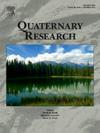加拿大高北极福斯海姆半岛隆起海洋三角洲沉积物中冰川融水成因的大块地面冰
IF 1.8
3区 地球科学
Q3 GEOGRAPHY, PHYSICAL
引用次数: 0
摘要
在加拿大的北极高地,在尤里卡海峡低地(ESL)发现了大量的板状地面冰。本文基于海岸线和全新世海洋界线之间的新冰冻地层资料,对ESL凸起海洋三角洲沉积物中板状块状冰的发育进行了评价。在所有地点,在层状细粒海洋沉积物下方发现大块冰,冰与上覆海洋沉积物之间的上部接触是整合的和层次化的。大冰块中主要离子的浓度比预期的冰川冰高几个数量级,但Na/Cl的摩尔比随海拔而变化:高海拔地区的摩尔比与冰川冰相似,而低海拔地区的摩尔比更接近海水。冰的δ18O值表明水的主要来源是冰川融水,但δD-δ18O回归斜率值表明冰是在开放体系中形成的,同时接受了与初始储层具有明显不同同位素特征的流入。海洋三角洲沉积物中大块冰的形成涉及冰川融水对全新世海洋沉积物下含水层的补给,贡献了1-10%的海水。本文章由计算机程序翻译,如有差异,请以英文原文为准。
Massive ground ice of glacial meltwater origin in raised marine-deltaic sediments, Fosheim Peninsula, high Arctic Canada
In the Canadian high Arctic, tabular massive ground ice is found extensively throughout the Eureka Sound Lowlands (ESL). This study evaluates the development of tabular massive ice in raised marine-deltaic sediments of the ESL based on new cryostratigraphic data from sites found between the coastline and the Holocene marine limit. At all sites, massive ice is found below laminated fine-grained marine sediments, and the upper contact between the ice and the overlying marine sediments is conformable and gradational. The concentration of major ions in the massive ice is orders of magnitude higher than expected for glacial ice, but Na/Cl molar ratios vary following elevation: the higher-elevation site has ratios similar to glacial ice, but sites at lower elevations have ratios closer to seawater. The δ18O values of the ice indicate that the main source of water is glacial meltwater but the δD-δ18O regression slope values suggest that the ice formed in an open system while receiving an influx that had a substantially different isotopic signature than the initial reservoir. The development of massive ice in the marine-deltaic sediments involves glacial meltwater recharging an aquifer beneath the Holocene marine sediments with a contribution of 1–10% of seawater.
求助全文
通过发布文献求助,成功后即可免费获取论文全文。
去求助
来源期刊

Quaternary Research
地学-地球科学综合
CiteScore
4.70
自引率
8.70%
发文量
57
审稿时长
3 months
期刊介绍:
Quaternary Research is an international journal devoted to the advancement of the interdisciplinary understanding of the Quaternary Period. We aim to publish articles of broad interest with relevance to more than one discipline, and that constitute a significant new contribution to Quaternary science. The journal’s scope is global, building on its nearly 50-year history in advancing the understanding of earth and human history through interdisciplinary study of the last 2.6 million years.
 求助内容:
求助内容: 应助结果提醒方式:
应助结果提醒方式:


